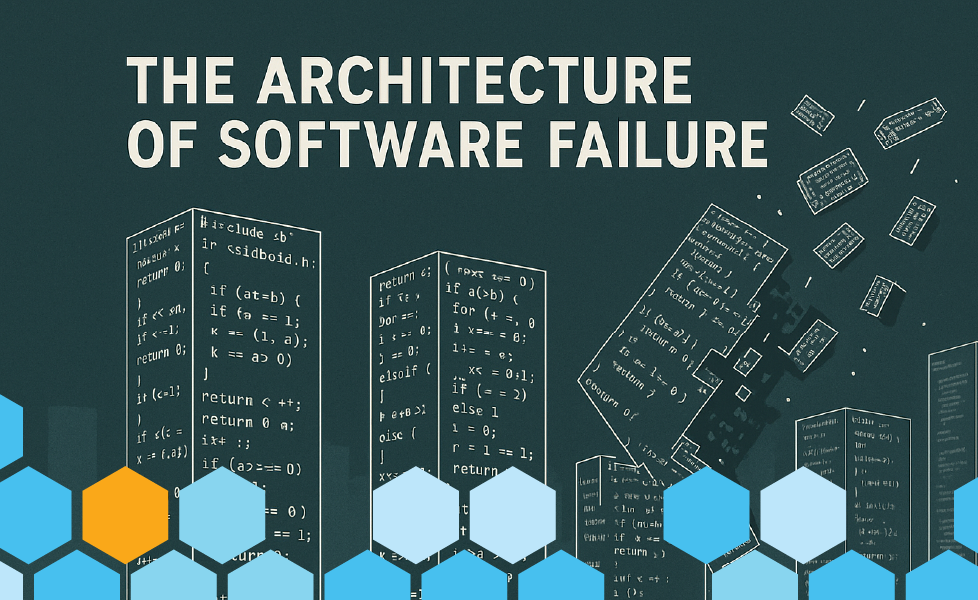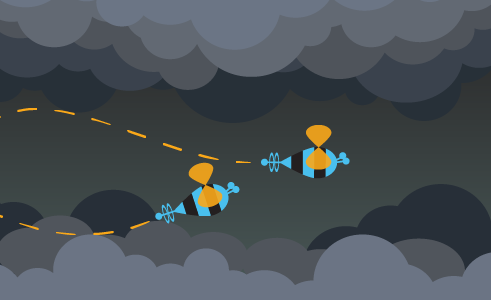The Architecture of Software Failure
Each software testing technique targets a distinct type of failure pattern. Skipping any of these techniques creates blind spots, turning partial coverage into predictable defects.
TABLE OF CONTENTS
Why Every Testing Technique Has a Purpose
Testing techniques are not just random tools in a toolbox. Each one is designed to target specific failure patterns that commonly affect software systems. Understanding the objectives of these techniques is not an academic exercise—it's the key to conducting comprehensive testing and avoiding costly guesswork.
The Myth of Universal Testing
Here's a question that should make every QA professional uncomfortable: If you could only use one testing technique for the rest of your career, which would you choose? The awkward truth is that this question reveals the fundamental misunderstanding plaguing our industry.
There is no silver bullet in software testing. There never was, and there never will be. Yet teams continue to treat testing techniques as interchangeable parts, believing that solid functional testing can somehow compensate for poor boundary-value analysis or that exploratory testing can replace systematic equivalence class partitioning.
This myth isn't just inefficient—it's dangerous. Software fails in predictable patterns, and each testing technique exists to catch specific types of failures that others simply cannot detect. When you skip techniques, you're not just cutting corners; you're leaving entire categories of defects unguarded.
Decoding the Objectives: What Each Technique Actually Tests
Let's be precise about what each major testing technique is designed to accomplish. These aren't theoretical distinctions—they represent fundamentally different ways software can break.
Equivalence Class Partitioning targets classification errors. It assumes that inputs falling within the same partition should behave identically. When this assumption breaks down—when the system treats supposedly equivalent inputs differently—you've found a defect that random testing might never discover. The objective here is systematic coverage of input domains without exhaustive testing.
Boundary Value Analysis hunts for off-by-one errors and edge condition failures. Software consistently fails at boundaries because programmers think in ranges but implement in discrete steps. This technique targets explicitly the mathematical errors that cause systems to accept invalid inputs or reject valid ones at critical thresholds.
Decision Table Testing exposes logical inconsistencies in complex business rules. When multiple conditions interact to determine outcomes, human reasoning fails predictably. This technique systematically tests combination logic that would be impossible to verify through ad-hoc testing approaches.
State Transition Testing reveals sequence-dependent failures. It targets defects that only emerge when the system reaches specific states through particular paths. These are the failures that work fine in isolation but break when executed in realistic operational sequences.
Domain Analysis Testing systematically partitions input and output domains to identify the complete set of conditions that must be tested. Unlike simple equivalence class partitioning, domain analysis creates mathematical models of program behavior to target computational errors arising from incorrectly implemented domain boundaries. This technique catches defects where the actual domain differs from the specified domain.
Pairwise Testing addresses the combinatorial explosion problem in parameter testing. When systems have multiple parameters with multiple values, testing every combination becomes impossible. Pairwise testing targets interaction failures between parameters by ensuring every pair of parameter values is tested together at least once. Research shows that pairs, not larger combinations, trigger most parameter-interaction defects.
Basis Path Testing focuses on testing all independent logical paths through your application. While state transition testing validates state behavior, basis path testing ensures we test every fundamental logical flow your application can execute. This technique is particularly valuable for complex applications that involve multiple decision points and conditional logic, and it targets structural coverage by ensuring that every independent execution path is tested at least once.
Use Case Testing validates end-to-end scenarios against business requirements. Its objective is to ensure that individual components working correctly still deliver business value when integrated. This technique catches integration failures that unit tests cannot detect by testing realistic operational workflows.
The Failure Pattern Map
Software doesn't fail randomly. Decades of industry experience have identified recurring failure patterns that appear across projects, technologies, and organizations. Here's the crucial insight: each testing technique maps to specific failure patterns.
Input Validation Failures emerge when systems process data outside expected ranges or formats. Equivalence class partitioning and boundary value analysis specifically target these patterns, systematically probing input domains where validation logic typically breaks down.
Domain Implementation Failures occur when the actual computational domain differs from the specified domain. Domain analysis testing specifically targets these mathematical and logical errors, where boundary conditions and domain partitions are incorrectly implemented in code.
Parameter Interaction Failures surface when multiple system parameters interact in unexpected ways. Pairwise testing systematically addresses these combination failures that emerge only when specific parameter values are used together, targeting the exponential complexity of multi-parameter systems.
Logic Processing Failures occur when complex business rules interact unexpectedly. Decision table testing systematically examines these interaction failures that simple linear testing approaches miss entirely.
Control Flow Failures happen when code execution follows unintended paths through the application structure. Basis path testing specifically targets these structural errors by ensuring complete coverage of independent execution paths, catching logic errors that ad hoc testing might miss.
State Management Failures emerge when systems reach invalid states or transition incorrectly between states. State transition testing systematically validates state behavior and transition logic, targeting failures that only appear in specific operational sequences.
Integration and Workflow Failures occur when components that are correctly functioning fail to work together in realistic scenarios. Use case testing targets these systemic failures that emerge only during end-to-end operational flows.
The critical realization is this: if you're not using a technique that targets a specific failure pattern, you're not testing for that type of failure at all. There's no overlap, no redundancy, no safety net.
Why Partial Coverage Equals Complete Failure
Here's where most organizations get it wrong. They treat testing techniques like a menu, selecting their favorites while ignoring others they find inconvenient or time-consuming. This approach fundamentally misunderstands the nature of software quality.
Consider a system that receives comprehensive equivalence class partitioning and boundary value analysis but skips pairwise testing. This system might handle individual parameter values flawlessly, but it fails when specific parameter combinations interact in production. The boundary testing didn't fail—it wasn't designed to catch parameter-interaction failures. That's what pairwise testing is for.
Or imagine a system with excellent use case testing but no basis path testing. The system meets all requirements but contains unexecuted application paths with logic errors that surface under specific operational conditions. The use case tests didn't miss anything—they were never intended to catch structural coverage gaps.
This isn't about testing "harder" or "longer." It's about testing smarter by understanding that different techniques target different failure modes. When you skip techniques, you're not reducing thoroughness—you're eliminating entire categories of defect detection.
The Mathematics of Incomplete Coverage
Let's quantify this with a simple example. Assume each major testing technique catches a unique 15% of potential defects (this is conservative—some techniques catch defect types that others miss entirely). Using only three techniques gives you 45% coverage, not the 80-90% that teams often assume.
More problematically, the remaining 55% of defects aren't just harder to find—they're completely invisible to your chosen techniques. These aren't edge cases within your testing scope; they're entire failure patterns outside your detection capabilities.
The Reality Check
The resistance to adopting comprehensive testing techniques isn't technical—it's cultural and economic. Teams resist learning multiple techniques because they're complex, time-consuming, and require genuine expertise to implement effectively.
But here's the uncomfortable truth: if your testing strategy can't detect the full spectrum of software failure patterns, you're not really testing—you're performing quality theater. You're going through familiar motions that provide comfort but not confidence.
The Business Case for Comprehensive Testing Technique Adoption
Organizations that implement comprehensive testing technique strategies consistently report significant improvements in software quality and business outcomes. According to the National Institute of Standards and Technology, improvements in testing infrastructure could reduce software defect costs by approximately one-third, representing billions in potential savings across the industry.
These improvements translate to:
- Substantial reduction in post-deployment defect remediation costs
- Faster release cycles due to increased confidence in software quality
- Lower total cost of ownership as defect detection shifts left in the development lifecycle
- Improved customer satisfaction and reduced support burden
These aren't marginal improvements—they're fundamental transformations in software reliability.
The Skills Gap Reality
Most QA professionals know the names of testing techniques but can't implement them effectively. They can define equivalence class partitioning, but struggle to partition complex input domains. They understand boundary value analysis in theory but miss critical boundaries in practice. They've heard of pairwise testing but can't calculate the necessary test combinations for multi-parameter systems.
This skills gap perpetuates the myth that techniques are optional. When teams can't implement techniques effectively, they rationalize their absence rather than investing in capability development.
Final Thoughts
Software testing isn't about finding some defects—it's about systematically addressing all major failure patterns that could impact users and business objectives. Each testing technique exists because it targets failure patterns that other techniques cannot detect.
The question isn't whether you have time to learn and implement comprehensive testing techniques. The question is whether you can afford the consequences of missing entire categories of defects that only surface in production.
At Testaify, we've built our AI-first platform around this fundamental truth: comprehensive testing requires comprehensive coverage of testing techniques. Our platform doesn't just automate testing—it ensures that all major failure patterns are systematically addressed through appropriate technique application.
The era of partial testing coverage is ending. Organizations that continue treating testing techniques as optional will find themselves competing against teams that understand the science of systematic defect detection. In that competition, there's only one possible outcome.
Testing techniques aren't just tools—they're the foundation of software reliability. Use them all, or accept the consequences of the failures you'll never see coming.
About the Author
 Testaify founder and COO Rafael E. Santos is a Stevie Award winner whose decades-long career includes strategic technology and product leadership roles. Rafael's goal for Testaify is to deliver comprehensive testing through Testaify's AI-first platform, which will change testing forever. Before Testaify, Rafael held executive positions at organizations like Ultimate Software and Trimble eBuilder.
Testaify founder and COO Rafael E. Santos is a Stevie Award winner whose decades-long career includes strategic technology and product leadership roles. Rafael's goal for Testaify is to deliver comprehensive testing through Testaify's AI-first platform, which will change testing forever. Before Testaify, Rafael held executive positions at organizations like Ultimate Software and Trimble eBuilder.
Take the Next Step
Testaify is in managed roll-out. Request more information to see when you can bring Testaify into your testing process.




